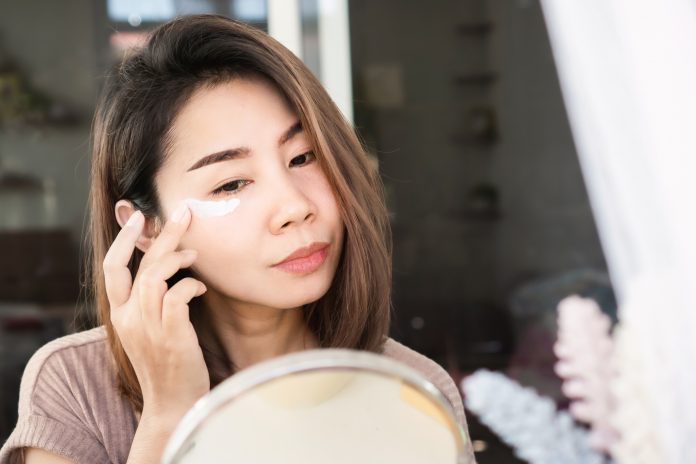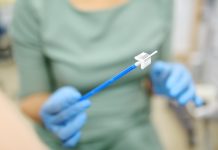Dr Deborah Lee, Dr Fox Online Pharmacy, tells us all about periorbital hyperpigmentation, including what causes it and how it can be treated
Do you look in the mirror every day, like I do, and worry about those dark circles under your eyes? I don’t much like being a panda look alike. I decided to research what causes this dark discolouration, proper name – periorbital hyperpigmentation.
- What causes it?
- What can you do about it?
Read on and find out.
What causes under eye dark circles and eye bags?
Understanding what causes dark circles under the eyes, is the first step towards the creation of successful skin treatments. There is no single cause, it seems to be due to a combination of factors. Below is a list of possible reasons –
- Photoageing – Skin changes around the eyes are one of the first signs of ageing. These tend to occur in the third decade of life. Many of these changes are directly due to the effects of photoageing – skin damage from ultraviolet radiation. However, they also result from damage due to environmental factors including toxins, smoking, and air pollution.
- Effects of eye blinking – The skin around and under the eyes is not only thin and delicate but is also subjected to a great deal of stress every day, due to the process of blinking. When we blink, this uses twenty-two different eye muscles working together, to create over ten thousand blinks per day! The area under the eyes also has less subcutaneous fat than other parts of the face and comparatively fewer sebaceous glands.
- An Increase in the deposition of melanin – Ageing around the eyes results in periorbital hyperpigmentation (dark circles), swelling, puffiness, fine lines and wrinkles. The dark discolouration seen with the appearance of dark circles under the eyes, which frequently also affects the upper eyelids, as its name suggests, is due to excess deposition of the skin pigment, melanin. This ‘panda effect’ makes the affected individual look stressed and tired.
Stress, lack of sleep, disruption of natural Circadian rhythms, and raised cortisol levels can all lead to increased deposition of melanin.
- Other contributory factors – These include changes in skin laxity, post-inflammatory hyperpigmentation (secondary changes that occur for example due to atopic eczema), and local poor blood circulation. Natural skin thinning due to ageing, further exposes the network of blood vessels under the eye, giving a purplish appearance to dark circles under the eyes.
- Leaky capillaries – Sometimes the tiny skin capillaries under the eyes can leak, into the surrounding tissues. This means the heme part of the haemoglobin molecule – the part that contains iron – causes a local inflammatory reaction. Increased oxidative stress leads to the production of dangerous free radicals, with local cell death and cell clearance. As a result, haemosiderin – a complex type of ferritin – is deposited in the skin. This can give the blue/grey colour to under-eye circles.
- Skin inflammation and eye bags – Inflammation in the skin can make the skin appear red and swollen, and cause under-eye bags. This often occurs in conjunction with poor skin hydration.
Under-eye puffiness may be caused by a combination of lifestyle factors. These include smoking, drug, and alcohol intake. A high salt diet may also cause the skin to be dehydrated. Seasonal changes such as hay fever and allergies can also exacerbate puffiness. If your eyes are itchy and you frequently rub your eyes, this again makes the condition worse.
As we age, there is a natural tendency for the lymphatic drainage of the skin to become less efficient, meaning water tends to accumulate locally in the under-eye tissues. Continued exposure to U/V light also tends to worsen these effects, while also promoting the formation of fine lines and wrinkles.
- Reduced collagen – Wrinkling around the corners of the eyes occurs largely due to an age-related decline in collagen production and an increase in collagen degradation.
- Reduced elastin – There is also a loss of elastin production. The major skin-support proteins belong to a group called glycosaminoglycans (GAGs) – these include chondroitin sulphate (CS), heparan sulphate (HS), and hyaluronic acid (HA). As we age, GAGs are remodelled, resulting in the loss of elastotic material in the skin. Overall, the skin is less able to trap and retain water and begins to look more fragile, and tired.
- Additional causes – Lack of sleep, rubbing your eyes due to eye allergies, such as hay fever, and smoking, can also lead to dark circles under the eyes. It can also be a side effect of various drugs, including some eye drops used to treat glaucoma.
What to do about periorbital hyperpigmentation
The aim of treatment is to firm up the skin by restoring elasticity. A skin cream can be applied around and under the eyes containing specific types of glycosaminoglycans (GAGs), for example, heparan sulphate (HS), because these molecules are small enough to gain entry to the skin. Research studies have shown that the application of HS improves skin hydration and helps restore the barrier function of the skin. This leads to better firmness and elasticity.
Medical research
How effective are eye creams?
In one 2019 study, a group of fifteen men and women, who all had major concerns about discolouration around the eyes, skin puffiness, hyperpigmentation, fine lines and wrinkles, were asked to use a specially formulated skin cream around the eye area, twice a day, for twelve weeks. Before application, they used a standard skin cleanser.
The eye cream contained HS, along with some other carefully chosen ingredients. Even after just two weeks of treatment study, subjects could see improvements in periorbital pigmentation, and reductions in coarse and fine wrinkles. 73% of subjects also reported a reduction in puffiness around the eyes, and 93% reported a reduction in dark circles.
The skin cream also contained naturally derived extracts: Tephrosia purpurea seed extract (1%‐4%), E Crustaceum plankton extract (1%‐4%), Hieracium pilosella (1%‐3%), and Bellis perennis flower (1%‐3%) extract.
Hieracium pilosella and Bellis perennis flower extract are thought to help prevent the breakdown of heme and prevent the stimulation of melanocytes. Crustaceum plankton extract reduces vascular permeability and helps prevent tissue swelling. Tephrosia purpurea seed extract was used to try and help restore the cortisol imbalance.
The authors concluded that the use of the eye cream tested, resulted in total improvements in many of the different features of periorbital skin conditions and that further research was indicated.
Differences between male and female skin
Strange as it may seem, there do seem to be some specific differences between male and female skin.
In one 2018 review of medical research studies, the authors identified 1070 publications, but only 57 were suitable for inclusion. Overall, they found that almost all skin parameters were more pronounced in men than women, apart from the skin pH. Men tended to have higher levels of hydration, sebum, microcirculation, pigmentation, and skin thickness, and reduced levels of transepidermal water loss, than women.
Previous research has shown major differences in the skin of men and women due to the complex interplay of testosterone and estrogen on the skin. These can affect the skin thickness, as well as local immune function. In general, men seem more susceptible to infective skin conditions, whereas women are substantially more prone to develop autoimmune skin conditions. Hormones also affect the response of the skin to ageing.
Men who are concerned about their appearance tend to focus on three specific areas, the hairline, the periorbital area (around the eyes), and the jaw. Men are often very worried about losing their hair, and about dark circles and bags, under their eyes.
Women are said to worry about their skin for around 32 minutes a day! They mostly worry about acne, signs of skin ageing, and dark circles under their eyes.
Management
- Always protect your skin from the sun – Wear sunscreen every day, even in the winter, that contains at least SPF-30 anti-UVB protection and has four out of five stars for anti-UVA protection. In the summer you may need much higher protection such as SPF-50. Wear a wide brimmed hat, sunglasses, and keep your face out of the sun.
- Treat your allergy symptoms – This is to help stop you from constantly rubbing your eyes. Ask the pharmacist about allergy treatments such as antihistamine tablets, eye drops and nasal sprays.
- Remove make-up with a gentle skin cleanser and cotton wool – Wash with warm water and pat dry. Apply moisturiser to the face liberally. It’s vital to keep your skin moist and supple. You can find out more about recommended moisturisers for ageing skin – here.
- Make sure you get enough sleep – You need 7-9 hours of good quality sleep per night.
Skin creams for periorbital hyperpigmentation
Consultant Dermatologists recommend the following –
- Ceramides – Try using a cream containing a ceramide. These act as humectants, to help trap water in the skin. Hyaluronic acid, for example, is believed to hold one thousand times its own weight in water! HA can also be used as a filler.
- Vitamin B3 (niacinamide) reduces the reddening of the skin and stimulates the skin to produce collagen. Collagen is the major protein in the body and makes up of a large proportion of the connective tissue in the skin, muscles, joints and ligaments. Collagen can be thought of ‘scaffolding.’ Better scaffolding will support the skin better.
- Retinoids can be used with care to help encourage the exfoliation of hyperpigmented skin cells. They also help stimulate collagen production.
- Other vitamins added to skin creams can help dark circles under the eyes, including vitamins, A, C and E. Vitamin C is a very powerful antioxidant vital for skin health. These three vitamins also stimulate collagen production.
- Azelaic acid is sometimes used because it inhibits the enzyme tyrosinase, needed to make melanin.
- Kojic acid, derived from mushrooms, is also known to reduce hyperpigmentation.
- Caffeine – Yes, it’s true! Putting used tea bags under your eyes may help. This is because caffeine is a vasoconstrictor, hence causing small blood vessels near the skin surface to narrow. This reduces blood flow to the skin surface. Alternatively, you can purchase caffeine-containing eye cream.
It’s difficult to recommend specific skin products to treat periorbital hyperpigmentation as there are so many on the market, but you can find a good list of suggestions – here.
Final thoughts
Now we know more about periorbital hyperpigmentation, we can take steps to improve it. Research suggests using the right eye creams can lead to a marked improvement. It’s also important to eat well, sleep well, and generally look after yourself. Let’s remember, our eyes are the window of the body. We do need to keep them in tip-top condition – so that includes – looking after the skin they are in!
For more information
- DermNet NZ – Dark circles under the eyes
References
https://www.ncbi.nlm.nih.gov/pmc/articles/PMC6850077/











